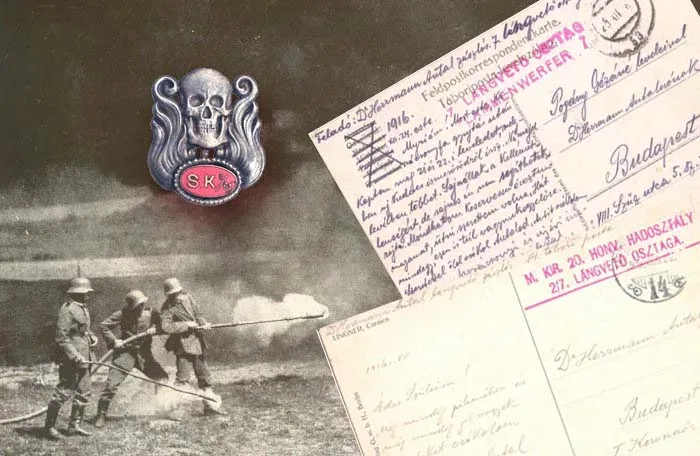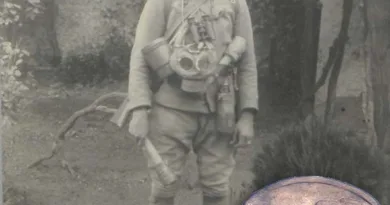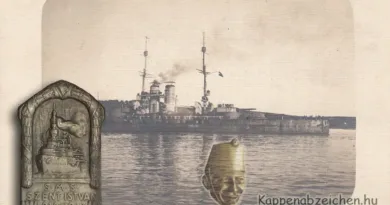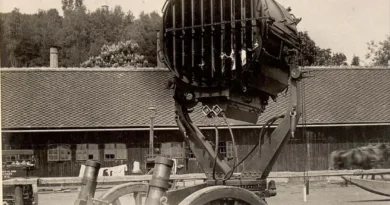Flamethrower
There is a very exciting Kappenabzeichen with a skull between flames and SK 3/61 on a red background. I’ve always been searching for the meaning of this badge very much, because it must have been the insignia of some kind of elite troop. The skull usually appeared on the badges of assault troops. But what do the flames represent? And why aren’t there the words that the badges of assault teams usually labeled (Rohamcsapat, Sturmtruppe, Sturmkompagnie, Sturmbaon)? Then I got my hands on Christian Ortner’s little book of Sturmtruppen, and it all came to light. The flames and the inscription SK 3/61 relate to the 3rd company of a special unit, the 61st Sapper Battalion.

The flamethrower is one of the terrible destructive weapons and military development of World War I. I don’t think I need to write much about its effect. It was able to transport the burning phosphorus compound over a considerable distance. It also penetrated cover and bunkers that could only be accessed up by close combat of conventional infantry weapons. Its effect, on the other hand, was known to be horrific.

It was used in both attack and defense. The smaller portable device with a 22-litre tank was operated by two operators in an attack. The device, which had a 50-litre tank, was mostly used in position and defense. In 1916, the application already began in the Army of the Monarchy. In January 1916, the M 15 50-litre version built into the position was certainly used in the Toporoutz and Rarancze areas in order to counter the attack by the Russian 7th Army. The use of smaller, portable devices may have also started as early as 1916.

The flame throwers were operated by the sapper units assigned to the divisions. In general, it was their job to carry out military technical tasks. Of course, as the use of the devices spread, it became necessary to train the selected infantry crew in special training courses for the use of technical equipment. Sappers’ task was not only to study the effect of operation or use, or to learn the necessary precautions. They also experimented the suitable combat procedures associated with the instruments. From 1917, training took place in two places, Krems and Huszt. A special unit has been formed for this purpose, the 61st Sapper Battalion with four squadrons. The battalion in this organizational order was deployed in combat first in the 12th Isonzo battle.

It was then evidenced that the portable flame thrower was most effective in cooperation with assault troops. The assault team breaks through the enemy obstacle system, overcoming the most important defensive foci of the first line. After that, the flame throwers start, who are less mobile and very vulnerable due to the carrying of the heavy tank. Their task is to clean up overran lines of defense from all resistances. They literally smoke out sporadic resistance points that didn’t want to surrender. This combat procedure led to success in many places in October 1917, and the Austro-Hungarian military ordered the four squadrons of the 61st Sapper Battalion to be distributed in support of the assault troops of four corps in the 11th army on the Italian front. The 1st company was transferred to the 1st Corps, the 2nd to the XXVI, the 3rd to the III, the 4th company to the VI Corps. In addition to carrying out their own combat tasks, the four companies also trained additional flamethrower platoons and tested new devices.
The badge on the main photo of this post is therefore the badge of the 61/3 flame-thrower company deployed to the III Corps. The script S.K 3/61 means Sappeur Kompanie 3/61.





Another excellent article on a fascinating badge. I knew what the badge was for, but I didn’t know the tactical level deployment of the various sappaer companies within the Army, but I do now thank you.
Thank you Ian! The laudation was deserved by Ortner who described the story in his books. I looked through them again, and could find out that the 50 l built in flamethrower was in use already in 1915. The smaller portable devices were produced and in use from 1916. The already existing flamethrower platoons were gathered together to form the 61st sapper battalion in 1917. The intention was to train the usage of the device in offensive operations. Those units that had already been subordinated to the Sturmtruppe remained back with their operational units. The first massive action of the battalion was the 12nd Isonzo battle. Ortner sais that in many cases the special sapper units were used by the commanders for ordinary sapper tasks. They considered them as additional reinforcement. In many cases they had to live back their instruments even! But in those cases where they were applied together with regular infantry assault troops they proved to be very successful.
[…] 1912, an additional stone drilling unit was organized during the Great War. In February 1916, the 61st Sapper Battalion was formed to handle flamethrowers and prepare for gas […]